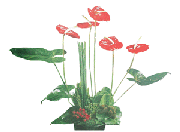 Since customers are dependent on florists during the cold season, they should learn how to be discriminate shoppers. It is often better to buy just one to three of the same blossoms with buds and a few unusual leaves than to get more identical blossoms. Flower arrangements should express a definite idea.
Since customers are dependent on florists during the cold season, they should learn how to be discriminate shoppers. It is often better to buy just one to three of the same blossoms with buds and a few unusual leaves than to get more identical blossoms. Flower arrangements should express a definite idea.
 Art principles
Art principles
The design principles by which we judge art also apply to flower arrangements. Since proportion is necessary, it is recommended the plants be about 1.5 times as high as a tall vase or 1.5 times as high as the diameter of a wide vase. Emphasis on the best flowers is produced by subordinating the others, including the receptacle. Transition occurs when there is a medium-sized object or plant arranged between the large and small flowers, or when a particular hue is used to harmonize the other colors.
 Types of flower arrangements
Types of flower arrangements
Flower compositions usually come in four different types:
1. Line arrangements: A few flowers, leaves and buds are arranged naturally to display their characteristic lines of growth.
2. Mass or composite bouquets: Many flowers are arranged together according to color and texture.
3. Platter bouquets: Only the heads or blossom ends of flowers are displayed in flat receptacles.
4. Geometric bouquets: Flowers are arranged in design formats.
Line Arrangements. Many flowers, berries, seed pods and branches are suitable for line arrangements. Flowers like jonquils, irises, and lilies are ideal for line compositions, as are lilac, maple, elm, willow, or fruit tree branches, which bloom many weeks earlier indoors. They exhibit a type of beauty that is often overlooked.